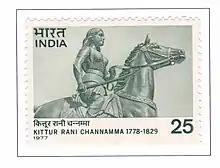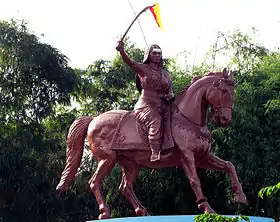Kittur Chennamma
Kittur Chennamma (23 October 1778 – 21 February 1829)[1] was the Indian queen (rani) of Kittur, a princely state in present-day Karnataka. She led an armed rebellion against the British East India Company in 1824 in defiance of the doctrine of lapse in an attempt to maintain Indian control over the region, but was defeated and died imprisoned. One of the first female rulers to rebel against British rule, she has become a folk hero in Karnataka and symbol of the independence movement in India.
Kittur Chennamma | |
|---|---|
 Kittur Chennamma on a 1977 Stamp of India | |
| Born | Chennamma 23 October 1778 Kakati, Kingdom of Mysore, India |
| Died | 21 February 1829 (aged 50) Bailhongal, Princely State of Mysore, Company rule in India |
| Nationality | Indian |
| Other names | Rani Chennamma, Kittur Rani Chennamma |
| Known for | 1824 Revolt against the British East India Company |
| Parent(s) |
|
Early life
Kittur Chennamma was born on 23 October 1778, in Kakati, a small village in the present Belagavi District of Karnataka, India. She belonged to the Lingayat community and received training in horse riding, sword fighting and archery from a young age.
She married Raja Mallasarja of the Desai family at the age of 15.
Rebellion against the British
Chennamma’s husband died in 1824, leaving her with a son and a state full of volatility. This was followed by her son’s death in 1824. Rani Chennamma was left with the state of Kittur and an uphill task to save it from the British. Following the death of her husband and son, Rani Chennamma adopted Shivalingappa in the year 1824 and made him the heir to the throne. This irked the East India Company, who ordered Shivalingappa’s expulsion, on the pretext of the Doctrine of Lapse introduced by Lord Dalhousie, the then Governor General, to annex independent Indian States in 1848. This doctrine was based on the idea that in case the ruler of an independent state died childless, the right of ruling the State reverted or ‘lapsed’ to the sovereign. The state of Kittur came under the administration of Dharwad collectorate in charge of St John Thackeray of which Mr. Chaplin was the commissioner, both of whom did not recognize the new ruler and regent and notified Kittur to accept the British regime.
Rani Chennamma sent a letter to Mountstuart Elphinstone, Lieutenant-Governor of the Bombay Presidency pleading her cause, but the request was turned down, and war broke out.[2] The British tried to confiscate the treasure and jewels of Kittur, valued at around 1.5 million rupees.[3] They attacked with a force of 20,797 men and 437 guns, mainly from the third troop of Madras Native Horse Artillery.[4] In the first round of war, during October 1824, British forces lost heavily and St John Thackeray, collector and political agent,[5] was killed in the war.[2] Amatur Balappa, a lieutenant of Chennamma, was mainly responsible for his killing and losses to British forces.[6] Two British officers, Sir Walter Elliot and Mr. Stevenson[5] were also taken as hostages.[2] Rani Chennamma released them with an understanding with Chaplin that the war would be terminated but Chaplin continued the war with more forces.[2] During the second assault, subcollector of Solapur, Mr. Munro, nephew of Thomas Munro was killed.[5] Rani Chennamma fought fiercely with the aid of her deputy, Sangolli Rayanna, but was ultimately captured and imprisoned at Bailhongal Fort, where she died on 2 February 1829.[2] Chennamma was also helped by her henchman Gurusiddappa in the war against British.[7]
Sangolli Rayanna continued the guerrilla war to 1829, in vain, until his capture.[2] He wanted to install the adopted boy Shivalingappa as the ruler of Kittur, but Sangolli Rayanna was caught and hanged. Shivalingappa was arrested by the British.[2] Chennamma's legacy and first victory are still commemorated in Kittur, during the Kittur Utsava held on 22–24 October annually.
Memorials
Burial place
Rani Chennamma's samadhi or burial place is in Bailhongal taluk, and is currently in a poor state due to poor maintenance of the surrounding park area by Government agencies.[8]
Statues
- Parliament House, New Delhi

On 11 September 2007 a statue of Rani Chennamma was unveiled at the Indian Parliament Complex by Pratibha Patil, the first woman President of India.[9] On the occasion, Prime Minister Manmohan Singh, Home Minister Shivraj Patil, Lok Sabha speaker Somnath Chatterjee, BJP leader L. K. Advani, Karnataka Chief Minister H. D. Kumaraswamy and others were present, marking the importance of the function.[10] The statue was donated by Kittur Rani Chennamma Memorial Committee and sculpted by Vijay Gaur.[10]
- Others
There are also statues commemorating her at Bangalore, Belgaum, Kittur and Hubli.[8]
In popular culture
- The heroics of Kittur Rani Chennamma are sung by folk in the form of ballads, lavani and GiGi pada.[11]
- Kittur Chennamma is a 1962 film in Kannada, directed by B. Ramakrishnaiah Panthulu with B. Saroja Devi in the title role.[12]
- A commemorative postage stamp was released on 23 October 1977 by Government of India.
- Coast guard ship "Kittur Chennamma" was commissioned in 1983 and decommissioned in 2011.[13]
- The Indian Railways train Rani Chennamma Express connecting Bangalore and Miraj is named after her.
- Raiganj University Associate Professor Pinaki Roy's essay "Alternative History: A Postcolonial Rereading of Naikar’s The Queen of Kittur", published in the Indian Journal of Multidisciplinary Academic Research (ISSN 2347-9884), 1(2), August 2014: 105-15, offers several instances of critical references to literary representations of the Queen of Kittur.
- Rani Channamma University in Belagavi is named in her honour.
- Kittur Chennamma is the name of a Martian vessel in the "Reload" episode of the science fiction series The Expanse.
References
- "Rani Chennamma of Kitturu". pib.nic.in. Retrieved 21 February 2018.
- Gopalakrishnan, Subramanian (Ed.); Gopalakrishnan, edited by S. (2007). The South Indian rebellions : before and after 1800 (1st ed.). Chennai: Palaniappa Brothers. pp. 102–103. ISBN 9788183795005.CS1 maint: extra text: authors list (link)
- Disturbances at Kittur and the death of Mr. Thackeray. London: Parbury, Allen, and Company. 1825. pp. 474–5.
- Asiatic Journal Vol.3 (1830). The Occurrences at Kittur in 1824. London: Parbury, Allen, and Co. pp. 218–222.
- O'Malley, Lewis Sydney Steward (1985). Indian civil service, 1601–1930. London: Frank Cass. p. 76. ISBN 9780714620237.
- "Restore Kittur monuments". The Hindu. 1 October 2011. Retrieved 13 November 2012.
- "Kambar calls for research on Chennamma". The Hindu. 25 October 2012. Retrieved 6 November 2012.
- "Kittur Rani Chennamma's samadhi lies in neglect". The Times of India. 30 October 2012. Retrieved 6 November 2012.
- "Pratibha unveils Kittur Rani Chennamma statue", news.oneindia.in
- "Kittur Rani statue unveiled". The Hindu. 12 September 2007. Retrieved 5 November 2012.
- Datta, Amaresh (Ed.) (1988). Encyclopaedia of Indian Literature: devraj to jyoti, Volume 2. New Dehi: Sahitya Akademi. p. 1293. ISBN 9788126011940.CS1 maint: extra text: authors list (link)
- "Kittur Chennamma (1962)", imdb.com
- Varma, Dinesh M (28 June 2011). "Coast Guard to acquire 20 ships, 10 aircraft". The Hindu. Retrieved 13 November 2012.